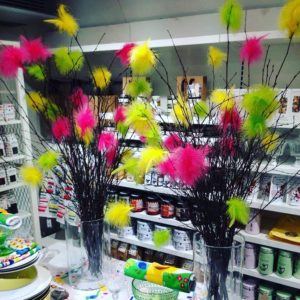Påsk (Easter) in Sweden is like anywhere else in the world, eggs, spring chickens and floppy-eared bunnies. There are a couple of strange additions, though…
and no, I haven’t lost it, or confused the time of year …the witches are about too.

Påskhäxa
Påsk- a very brief history
The word Påsk comes from the Hebrew word “pesah” meaning passing. Traditionally, the start of Påsk is celebrated in Sweden by painting eggs and children dressing up as Easter witches (Påskkäring) going from door to door and collecting candy (Halloween, no?). This tradition is a mixture of old pagan and orthodox traditions reaching right back to 1500’s. It is believed the witches flew over Sweden on Maundy Thursday on their way to a Mountain called Blåkulla, where the devil resides, to have their wicked ways with him.
More recently, the Easter holidays are about reconnecting with nature and cleaning out the dust and dirt from Winter in preparation for the Spring and Summer months. Many city dwellers head off to their Summer cottages for the first time since closing up at winter to prepare for their Easter celebrations.
Påskbordet
Like any Swedish holiday or “fest” a food table and drinking plays a BIG part in the celebrations. Sill, or pickled herring (bowk) is the food of choice, and ask any Swede what Easter means and they’re bound to say “Sill och nubbe”. Nubbe are small bottles of snaps/aquavit/fire-water which most Swedes bring with them to any fest, like a travelling mini-bar.

travelling mini-bar
So, if you are invited to “Påskbordet”, don’t forget your nubbe!!
Påsk for kids
Historically, Påsk isn’t about easter egg hunts, easter bonnet competitions and egg rolling in Sweden, although they love a good egg painting competition! For children, it’s more about dressing up as Påskhäxa/Påskkärring in Grandma’s old apron and headscarf, decorating Påskris with painted eggs and preparing the decorations for Påskbordet. But, of course, most importantly, eating all the godis inside their påskägg.
You’ll be hard pushed to find a hollow chocolate egg for Easter in Sweden. Påskägg’s are usually beautifully decorated, papermache and hollow. You fill each egg to the bring with candy and other sweet treats and give to loved ones.
In more recent years, “Hitta Påskägg” events have become more popular, a western influence and are usually arranged by Kommuns and Stads.
I’ve put together a list of Påsklov activities in English and in Swedish for the easter holidays – keep a look out on the blog!
Glad Påsk Allihopa! xx

Påskägg hand painted – photo credit publicdomainpictures.net
